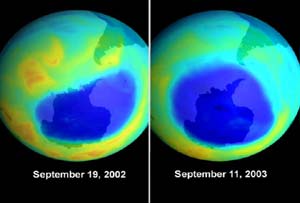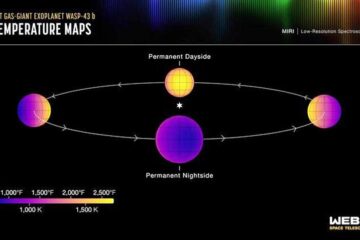Latest News

2003 Ozone ’Hole’ Approaches, But Falls Short Of Record
This year’s Antarctic ozone hole is the second largest ever observed, according to scientists from NASA, the National Oceanic and Atmospheric Administration (NOAA), and the Naval Research Laboratory (NRL). The Antarctic ozone “hole” is defined as thinning of the ozone layer over the continent to levels significantly below pre-1979 levels. Ozone blocks harmful ultraviolet “B” rays. Loss of stratospheric ozone has been linked to skin cancer in humans and other adverse biological effects on plants

Software tackles protein pathways
When biologists want to compare different sequences of DNA or protein, it’s as simple as plugging the information into a browser and pressing enter. Within 15 seconds, an online software tool contrasts one sequence of DNA with up to 18 million others catalogued in public databases. Now, a software tool developed by Whitehead Institute scientists promises to apply this same computational muscle to the far more intricate world of protein interaction networks, giving researchers a new view of the comple

Fibroblasts hold clues to fat, scars and inflammation
Scientists used to think that fibroblasts – the cells that form basic tissue structures – were little more than scaffolding on which more important cells would climb. But University of Rochester Medical Center scientists have discovered that certain fibroblasts have highly specialized duties and play a major role in how scars form, fat accumulates, and harmful inflammation arises in humans.
The research is published in The American Journal of Pathology, October 2003 edition. The work may he

New gene for rare inherited paralysis may aid other spinal cord research, too
Discovery holds immediate promise for diagnosis & treatment of hereditary spastic paraplegia
A single mutation in a single gene is enough to slowly rob people of their ability to walk, scientists from the University of Michigan and the University of Pennsylvania report today.
And while the inherited defect itself is rare, its discovery may help researchers unravel the mysteries of much more common paralyzing conditions, from spinal cord injury to Lou Gehrig’s disease.

Deep brain stimulation offers benefits against Parkinson’s
Deep brain stimulation via electrodes implanted on both sides of the brain markedly improves the motor skills of patients with advanced Parkinson’s Disease, says a new long-term study by researchers at the University of Toronto and Toronto Western Hospital.
“We saw a pronounced decrease in the motor scores associated with Parkinson’s Disease – the tremors, stiffness and slowness – and this benefit was persistent through the course of the long-term followup,” says Dr. Anthony Lang,

Real-time ’movies’ will predict wildfire behavior for one hour
Collaborative project promises new approach to battling fires
Someday fire fighters will be able to manage wildfires by computer.
Rochester Institute of Technology recently won a $300,000 grant from the National Science Foundation to translate remote-sensing data about wildfires into real-time “mini-movies” that fire managers can download on laptop computers at the scene of a blaze. The model and visualization will predict the fire’s behavior for the following hour.











